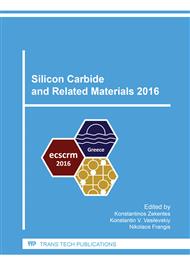[1]
P. Roussel, SiC Market and Industry Update, International SiC Power Electronics Applications Workshop, ISiCPEAW, Kista, Sweden, (2011).
Google Scholar
[2]
J. Millán, P. Godignon, X. Perpiñà, J. Rebollo., A survey of wide band gap power semiconductor devices, IEEE Trans. on Power Electronics, vol. 29, no. 5, pp.2155-2163, (2014).
DOI: 10.1109/tpel.2013.2268900
Google Scholar
[3]
http: /www. genesicsemi. com/index. php/sic-products/schottky.
Google Scholar
[4]
http: /www. wolfspeed. com/power/products/sic-mosfets/table.
Google Scholar
[5]
http: /www. rohm. com.
Google Scholar
[6]
M. K. Das, Recent Advances in (0001) 4H-SiC MOS Device Technology, Materials Science Forum, vols. 457-460, pp.1275-1280, (2004).
DOI: 10.4028/www.scientific.net/msf.457-460.1275
Google Scholar
[7]
P. Fiorenza et Al., SiC/4H-SiC interface doping during post-deposition annealing of the oxide in N2O and POCl3, Applied Physics Letters, Vol. 105 , nº15, Oct. (2013).
DOI: 10.1063/1.4824980
Google Scholar
[8]
D. Okamoto, H. Yano, K. Hirata, T. Hatayama and T. Fuyuki, Improved Inversion Channel Mobility in 4H-SiC MOSFETs on Si Face Utilizing Phosphorus-Doped Gate Oxide, IEEE Electron Dev. Lett., vol. 31, no. 7, pp.710-712, (2010).
DOI: 10.1109/led.2010.2047239
Google Scholar
[9]
D. J. Lichtenwalner et Al., High-Mobility SiC MOSFETs with Chemically Modified Interfaces, Materials Science Forum, Vols. 821-823, pp.749-752, June (2015).
DOI: 10.4028/www.scientific.net/msf.821-823.749
Google Scholar
[10]
D. Okamoto et Al. Improved Channel Mobility in 4H-SiC MOSFETs by Boron Passivation, IEEE Electron Device Letters, vol. 35, no. 12, p.1176–1178, Dec. (2014).
DOI: 10.1109/led.2014.2362768
Google Scholar
[11]
M. Cabello, V. Soler, J. Montserrat, J. Rebollo, J. Millán and P. Godignon, High mobilities SiC N-MOSFET using nitrided gate oxide with Boron diffusion treatment,. Proc. of E-MRS, Symposium L, Lille (France), May (2016).
DOI: 10.1109/ispsd.2016.7520833
Google Scholar
[12]
V. Soler, M. Cabello, M. Berthou, J. Montserrat, J. Rebollo, J. Millan, P. Godignon, E. Bianda, A. Mihaila. 4. 5kV SiC power MOSFET with Boron Doped Gate Dielectric. ISPSD (2016).
DOI: 10.1109/ispsd.2016.7520833
Google Scholar


